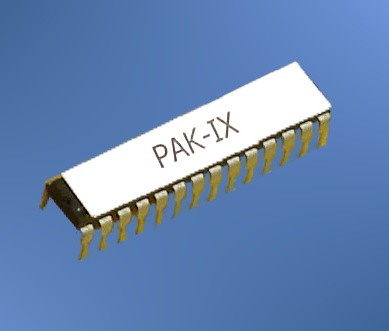
AWC Electronics - PAK IX and PAK X Floating Point A/D

Looking for a simpler way to do floating point math and analog I/O? Check out our new PAK-XII!
There's nothing more frustrating than trying to perform analog measurements with integer math. Even something as simple as averaging values is a real hassle. Why? Say you have a 10 bit A/D and you read 5 samples: 100, 105, 99, 92, and 103. The average is 99.8, but an integer average will result in 99 -- a big difference.
The PAK-IX combines 5 10-bit A/D channels with the math features of our PAK-II math coprocessor. Finally, you can perform acquisition and engineering unit conversion in floating point without loading your main processor.
The PAK-IX adds these powerful commands to the PAK-II's command set:
A2D (Command $29) - This command requires a single byte to be sent. The top 4 bits are the number of samples -1 (so 0 is 1 sample, %1111 is 16 samples). The bottom 4 bits indicate what channel to read (0-5). So to read 10 samples on channel 2, send $92. The command sums the samples and does a floating point divide, leaving the result in the X register. This command returns status (since it converts an integer to floating point).A2DCONF (Command $28) - Send a single byte to configure the A/D converter. Send 0 (the default) to use all 5 channels as normal A/D inputs. Send 1 to set AD3 as Vref+ and 8 to set AD3 as Vref+ and AD2 to Vref-.
ESTO (Command $2A) - Store data registers to EEPROM. Note this does not include X and Y, but the registers you normally access via STO and RCL.
ERCL (Command $2B) - Recalls data registers from EEPROM. This occurs automatically on reset.
One command can take multiple reading and average them in one step! Combined with the PAK II's POLY command and constants stored in EEPROM, it is easy to make the PAK-II automatically provide processed engineering units to the host microprocessor.
In addition to the 5 A/D channels (two of which may be used for reference), the PAK-IX has 8 digital I/O, and will perform all of the math functions a PAK-II can perform, so you get the extra benefit for floating point for your entire program.
You can read more about the part in our Document Library (particularly pak9.pdf and pak9ex.htm. You can also read a summary of changes between the PAK-II and the PAK-IX.
PAK-X
The PAK-X is a 5 channel, 10-bit A/D data acquisition coprocessor. You can set a high and low limit for each channel. The PAK-X will assert an output bit to indicate if a channel is out of limits. Each channel has a separate high and low limit output. In addition, the PAK-X remembers that the out of limit indication occurred and tracks the minimum and maximum value for each channel.
The PAK-X uses TTL-level RS-232 and provides the following features:
- Able to average each channel for noise reduction
- Selectable hysteresis for high and low limits prevents rapid cycling
- Latches high or low status for recall by host computer
- Stores minimum and maximum readings for recall by host computer
- Outputs can drive 25mA directly
- Scans inputs 1000 times per second minimum
How could you use the PAK-X? Suppose you are monitoring four production lines with a Basic Stamp. If the temperature rises above a certain value, you want to turn on a fan. The catch is, once an hour, the Stamp dials out to a PC via a modem. While this is happening, the Stamp isn't monitoring the temperature or controlling the fan. With the PAK-X, you can set the PAK-X so that it will turn on the appropriate fan when the temperature exceeds the high limit. If the Stamp is busy, the PAK-X will remember that the high limit condition occurred and will also record the maximum reading. That way the Stamp can get up to date when it is ready.
Of course, the Stamp (or other processor) can read the raw or averaged values. You can read the PAK-X manual online.
Get it Now!
Try a PAK-IX or X for 21 days. If you aren't delighted, just send it back undamaged for a full refund of your purchase price. But once you see your Stamp reading analog inputs as floating point numbers, you won't want to be without it.
Add to Cart PAK-IX Coprocessor (28 pin DIP w/resonator) $32.95 each
Add to Cart PAK-IX Coprocessor (Surface mount SOIC package w/through hole resonator) $34.95 each
Add to Cart PAK-X Coprocessor (28 pin DIP w/resonator) $24.95
Add to Cart PAK-X Coprocessor (Surface mount SOIC w/through hole resonator) $26.95
Our GPMPU40/28 PC board will easily fit a PAK-X and provides a 5V power supply, RS232 interface, and easy connection to external circuits.
Add to Cart GPMPU40/28 Full kit. Includes PC board, all core components, and instructions. $24.95 each
Notice: Basic Stamps are a product of Parallax Inc. AWC is in no way affiliated with Parallax.
Key Benefits
Saves development timeRead analog signals and perform computations without consuming CPU resources
Up to 5 channels of A/D with 10 bit resolution
The PAK-IX has powerful algorithms built in
Key Links
Guide to choosing a math coprocessor Manual (PAK-IX) Example Code PID Example Manual (PAK-X)Site contents © 1997-2018 by AWC, Houston TX (281) 334-4341